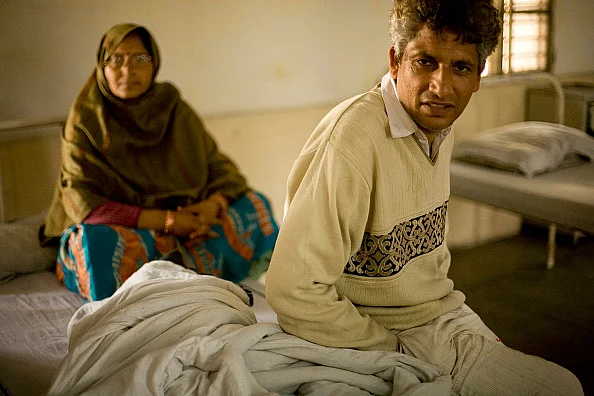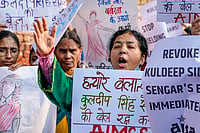
- Himachal Pradesh is witnessing a growing mental health crisis, affecting hundreds of individuals across various age groups
- The most common factors contributing to the alarming trend of mental illness in the state are depression, anxiety disorders, alcohol dependence, and substance abuse
- Due to the unavailability of data, the incidence of mental illness can only be estimated based on statistical prevalence
In the biting cold of December 2018, while driving through Jhakri—a suburban town nestled in the rugged mountain terrains of Himachal Pradesh, 130 kilometers from Shimla—Sandeep Sharma, an assistant professor at Government College Rampur, and his wife, Pooja Semta, came across a heart-wrenching sight.
An elderly man, approximately in his 60s, was aimlessly wandering by the roadside. Clad only in a thin dhoti-kurta and wearing worn-out chappals, he looked almost freezing in the icy wind. His face was etched with confusion and exhaustion after an endless journey on foot. He had no idea where he was headed.
It was immediately clear to the couple, both deeply involved in caregiving, that this man didn’t belong in the hills. His attire alone defied the harshness of the mountain winter. The couple approached him politely, inquiring about his name, place of origin, and intended destination.
It wasn’t just a moment of chance—it was a moment of humanity.
The man, later identified as Sachin Dass from Odisha, appeared completely disoriented and mentally unstable. He had neither money nor any belongings. He had no memory of how he ended up in Himachal. Sharma found it difficult to communicate with him because of a language barrier, as he only knew the native dialect. Yet, he could only make out that this wandering man was from Odisha.
The couple took him into their home, offered warm clothes, served him nourishing meals, and made a compassionate decision to care for him until they could trace his origins and help to reunite him with the family in Odisha.
Sharma got in touch with Ajai Srivastava, a journalist-turned-rights activist from Shimla-based NGO Umang Foundation, to trace his home with the help of the Shimla police and other agencies in Bhubaneswar. Srivastava also lost no time and spoke to Samanvay Nanda, a journalist there.
“At the same time, I reached out to an old journalist friend, Arun Bothra—now an IPS officer serving as Inspector General of Police (currently Additional DGP) in Odisha. He deployed his team to act on the clues provided by Nanda,” he recalls.
To their pleasant surprise, it was discovered that Dass had been serving as a priest at the Nar-Narayan Sewa Ashram Trust temple in Malkangiri district, Odisha. He had gone to perform the last rites of his mother, after which he went missing. Overwhelmed by grief and disoriented by the loss, he set out on a journey on Kailash Yatra, believing it would help attain salvation for his mother’s soul. Unaware of the route, he only knew that Mount Kailash was located somewhere in the Himalayas.
Eventually, after learning that Dass had been found in Himachal, the trust team arrived in Shimla. With the support of the police, the NGO, and the Sharma couple, he was safely brought back. Later, some medical intervention and caregiving in Odisha helped him recover fully, and in time, he conveyed his gratitude to Srivastava, and he still stays in touch with him.
The case of Dass is not an isolated one. Himachal Pradesh is witnessing a growing mental health crisis, affecting hundreds of individuals across various age groups, including a significant number of elderly and middle-aged, both male and female. They are lost, abandoned, and have no recollection of where they belong or even who they are.
The hill state, rather, faces a peculiar problem of wandering mentally ill patients, spotted all over the state. A few die in accidents along the National Highways or fall down hill slopes. Invariably, they succumb to the harsh cold of winter, the snowy season. Their unclaimed bodies at hospital mortuaries wait for some philanthropist or administration to cremate them.
There are still a few fortunate individuals who reunite with their families back home, thanks to the assistance of NGOs, caregivers, and government interventions.
Srivastava, the chairman of the Umang Foundation, says there is a serious lacuna in the Mental Health Care Act 2012, which suggests it’s the duty of the local Station House Officer (SHO) to identify such individuals loitering on the roads, to rescue them, and to get them medically examined. If declared mentally ill, it is his duty to take him/her to the court and obtain orders to send them to the mental care hospital or rehabilitation center.
In 2018, the Himachal Pradesh High Court bench headed by Justice Sanjay Karol—now a judge at the Supreme Court—reminded the police about the duty of the officer in charge of the police station under Section 23 of the Mental Health Act. The officer is required to take into protection any person wandering at large within the territorial area falling within his jurisdiction. He (the officer in charge) is also required to take care of individuals whom he has a reason to believe are suffering from mental illness and are incapable of taking care of themselves.
However, Srivastava states that the police often lack the time and manpower at police stations to handle such cases due to their busy schedules with law and order, investigations, and VIP duties. They thus find some easy ways out. One such thing happens in border districts.
“The wandering individuals are quietly relocated to neighboring states,” he explains, adding: “unless some NGOs or activists intervene to trace their origins and facilitate rehabilitation or reunion with their families post-treatment.”
One such landmark case is reuniting a mentally ill but fully cured woman, Padma Samptha, a woman from Mysore, who kept languishing at the Himachal Hospital of Mental Health and Rehabilitation in Shimla for the last two years, just because of a language barrier.
“The woman was found abandoned by the police in Kangra in 2016 and was brought to the hospital as a patient. Padma could speak only Kannada, which no one understood at the hospital or police. It was finally in 2018, when I established contact with Hyderabad-based journalist Swati and invited Sadhna Thakur, the wife of ex-CM Jai Ram Thakur, to meet this woman, that things started working. Swati also played a key role in tracing her origin in Karnataka,” recalls Suneela Sharma, a social activist and government college teacher.
Sadhna Thakur, a medical professional herself, who hails from Karnataka and has since become fluent in Kannada, interacted with Padma at the government rehabilitation center. By communicating with Padma, she found out that her husband and in-laws had abandoned her. She also gathered vital information about her parental family and brother.
Following these leads, the governments of Karnataka and Himachal Pradesh actively intervened to ensure the woman's reunion with her family. Eventually, a five-member team from Karnataka, which included Padma’s cousin, arrived in Shimla to safely bring her back home.
Before her cousin took over Padma’s custody, the ex-CM invited Padma to his residence as a goodwill gesture. He even passed orders to the state health department to monitor the rehabilitation of cured patients and reuniting them with their families.
Sanjay Pathak, who was the Sr. Medical Superintendent at the time, noted that Padma’s case paved the way for the rehabilitation and reunion of dozens of other cured patients with their families, as the government had developed a mechanism and proper protocol to rehabilitate such individuals from various states, including Kerala, Madhya Pradesh, Maharashtra, Andhra Pradesh, Assam, Tamil Nadu, and Punjab. However, the problems of abandonment persist in Himachal Pradesh.
Suneela Sharma has data about dozens of abandoned and mentally ill individuals at the Government Mental Hospital in Shimla and a private one in Kullu who have been reunited with their families. She was part of several such reunions of abandoned, missing, and wandering mentally ill individuals from different states.
However, Sharma says that Padma was not a case of mental illness but rather a lack of a mechanism to deal with wandering individuals. She was the first to reach out to
Padma at the rehabilitation center to learn about her background, and things started moving in her favour.
“The issue was simply a language barrier; the poor woman was unable to express her situation effectively. Often, she would break down and cry aloud. The hospital’s officials, too, felt helpless to do much except offer her timely food, shelter, and companionship. At least now, she should be reunited with the family,” she says.
Dinesh Dutt Sharma from the Department of Psychiatry at Indira Gandhi Medical College (IGMC) states that the most common underlying factors contributing to the alarming trend of mental illness in Himachal Pradesh are depression, anxiety disorders, alcohol dependence, and substance abuse.
However, due to the unavailability of data, the incidence of mental illness can only be estimated based on statistical prevalence. This is why the government has no estimate of how many mental health professionals—clinical psychologists, psychiatrists, social workers, counselors, and psychiatric nurses—are required.
Currently, preparations for NMHS-II (National Mental Health Survey-II) are underway with the goals of gathering essential data for policies and programs, addressing emerging mental health concerns, and establishing comprehensive mechanisms to tackle mental health issues nationwide. Himachal is one of the 28 states included in the NMHS-II, he says.
The condition of mentally ill patients, including those visiting hospitals, remains far from satisfactory. Many do not trust hospital-based treatment—whether outpatient or inpatient—due to social stigma. A significant number of these individuals turn to faith healers, often attributing their illness to the curse of local deities.
However, the greatest challenge, Pathak notes, lies in the lack of awareness among families about how to care for individuals with mental disorders. Neglect, denial of timely food, and loneliness force patients to either flee or, in some cases, they deliberately abandoned by their families.































